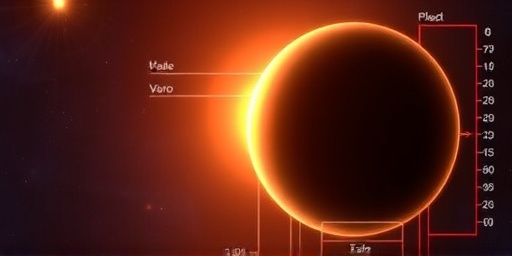In a groundbreaking revelation from the cosmos, NASA’s James Webb Space Telescope has peered into the hazy atmosphere of the exoplanet WASP-39b, detecting unmistakable signatures of water vapor and carbon dioxide for the first time with such clarity. This discovery, announced on August 24, 2022, marks a pivotal moment in exoplanet research, offering astronomers an unprecedented glimpse into the chemical makeup of worlds orbiting distant stars. The findings, published in the journal Nature, could reshape our quest to identify potentially habitable planets beyond our solar system.
Unveiling Water Vapor and CO2 Through Infrared Spectroscopy
The James Webb Space Telescope, often abbreviated as JWST, utilized its advanced Near-Infrared Spectrograph (NIRSpec) and Mid-Infrared Instrument (MIRI) to dissect the light passing through WASP-39b’s atmosphere during a transit event. As the exoplanet passed in front of its host star, the telescope captured a spectrum of infrared light, revealing absorption lines that pinpointed the presence of water vapor (H2O) and carbon dioxide (CO2). These molecules absorb light at specific wavelengths, creating a barcode-like pattern that scientists can decode to understand atmospheric composition.
According to the research team led by Natalie Cabedo at the University of Cambridge, the detection of CO2 is particularly significant because it provides clues about the planet’s formation history. “We saw the clearest possible sign of carbon dioxide we’ve ever seen in an exoplanet atmosphere,” said Cabedo in a NASA press release. Water vapor, while previously hinted at in WASP-39b’s atmosphere by the Hubble Space Telescope, was confirmed here with greater precision, showing concentrations that suggest a steamy, dynamic environment.
This spectroscopic analysis isn’t just about spotting molecules; it’s a window into the planet’s weather patterns and potential for cloud formation. The data indicates that WASP-39b’s atmosphere is rich in these compounds, with water vapor levels comparable to those in Earth’s upper atmosphere but on a much grander scale due to the planet’s size. NASA’s team estimates that the exoplanet’s atmosphere extends hundreds of kilometers, allowing for thorough mixing of gases that could influence its overall climate.
WASP-39b: Decoding the Profile of a Hot Jupiter Exoplanet
WASP-39b, discovered in 2011 by the Wide Angle Search for Planets (WASP) consortium, is a gas giant exoplanet located approximately 700 light-years away in the constellation Virgo. Orbiting a Sun-like star every four days, it resides in a scorching hot zone where surface temperatures soar to around 1,600 degrees Fahrenheit (900 degrees Celsius). This proximity classifies it as a “hot Jupiter,” a type of exoplanet known for its massive size—about 1.27 times Jupiter’s radius—and intense radiation from its parent star.
Despite its inhospitable conditions, WASP-39b serves as an ideal laboratory for studying exoplanet atmospheres because its large size and close orbit make transits frequent and observable. The James Webb Telescope’s observations during one such transit on July 10, 2022, lasted just over six hours, yet yielded terabytes of data that took months to process. Key facts about WASP-39b include its mass, which is roughly one-quarter that of Jupiter, and its low density, suggesting a puffed-up atmosphere dominated by hydrogen and helium, now augmented by the detected water and CO2.
Previous studies using ground-based telescopes and Hubble had suggested sulfur dioxide and other trace gases, but JWST’s superior resolution—thanks to its 6.5-meter primary mirror and position at the L2 Lagrange point—has elevated these to confirmed detections. “WASP-39b is like a cosmic test tube,” explained Mike Engler, another co-author from the Max Planck Institute for Astronomy. This exoplanet’s atmosphere, under constant bombardment from stellar winds, exhibits photochemical reactions that produce hazes and clouds, adding layers of complexity to its profile.
- Orbital Period: 4.055 days
- Distance from Star: 0.048 AU (much closer than Mercury to the Sun)
- Atmospheric Pressure: Estimated to be thousands of times Earth’s at the surface
- Notable Feature: Possible silicate clouds due to high temperatures vaporizing rocks
Understanding WASP-39b’s makeup helps astronomers model how gas giants form and migrate in young planetary systems, potentially influencing the development of inner, rocky worlds that might harbor life.
James Webb’s Technological Edge in Exoplanet Atmosphere Probes
The James Webb Space Telescope, launched on December 25, 2021, aboard an Ariane 5 rocket from French Guiana, represents NASA’s most ambitious observatory to date, costing over $10 billion and involving international partners from the European Space Agency (ESA) and the Canadian Space Agency (CSA). Positioned 1.5 million kilometers from Earth, JWST’s sunshield and cryogenic cooling allow it to observe in the infrared spectrum with sensitivity 100 times greater than Hubble’s.
For exoplanet studies, JWST’s instruments are game-changers. NIRSpec can resolve spectra from over 100 objects simultaneously, while MIRI extends observations into the thermal infrared, ideal for detecting cooler atmospheres or heat signatures. In the case of WASP-39b, MIRI’s data revealed not just CO2 but also hints of methane and possibly ammonia, broadening the chemical inventory.
NASA Administrator Bill Nelson hailed the mission’s success: “The James Webb Space Telescope is delivering on its promise to transform our understanding of the universe, one exoplanet at a time.” This observation is part of JWST’s Early Release Science program, which prioritizes high-impact targets to calibrate instruments and demonstrate capabilities. Since its first images in July 2022, JWST has already observed over 20 exoplanets, but WASP-39b stands out for the depth of atmospheric insight.
Comparatively, earlier telescopes like Spitzer detected broad atmospheric signals, but lacked the resolution to identify specific molecules. JWST’s precision means future surveys could scan thousands of exoplanets for biosignatures—gases like oxygen or ozone that might indicate life—accelerating the search for Earth-like worlds.
Revolutionizing the Hunt for Habitable Exoplanets
The detection of water vapor and carbon dioxide in WASP-39b’s atmosphere underscores the ubiquity of these life-essential molecules across the galaxy, even on uninhabitable hot Jupiters. Water, the universal solvent, and CO2, a key component in planetary atmospheres, are building blocks for habitability. While WASP-39b itself is too hot for liquid water, its data informs models for temperate exoplanets in the habitable zone, where temperatures allow for oceans and stable climates.
Astronomers now have a benchmark spectrum for comparing other exoplanets. For instance, the TRAPPIST-1 system, with seven Earth-sized planets, could be next on JWST’s list. “This is a proof-of-concept for what James Webb can do,” said Knicole Colón, an exoplanet expert at NASA’s Goddard Space Flight Center. “We’re moving from detection to detailed characterization, which is crucial for identifying worlds that might support life.”
Statistically, with over 5,000 confirmed exoplanets as of 2023, and estimates of billions more in the Milky Way, tools like JWST could prioritize candidates with water-rich atmospheres. The discovery also challenges formation theories: If hot Jupiters like WASP-39b formed farther out and migrated inward, they might have carried water from the outer disk, redistributing it to inner planets.
Broader implications extend to astrobiology. Carbon dioxide’s presence suggests carbon-rich environments, essential for organic chemistry. Combined with future detections of phosphorus or nitrogen, this could paint a picture of prebiotic chemistry on distant worlds. NASA’s Astrobiology Institute is already incorporating JWST data into simulations, predicting that within a decade, we might identify the first truly habitable exoplanet.
Upcoming Missions and the Next Frontier in Cosmic Exploration
Building on this success, NASA’s James Webb Space Telescope schedule includes Cycle 2 observations starting in 2023, targeting a diverse array of exoplanets from super-Earths to rogue worlds. Proposals for studying LHS 1140 b, a potential ocean world, and the atmosphere of Proxima Centauri b, our nearest exoplanet neighbor, are under review. These missions aim to detect seasonal changes or weather patterns, further demystifying exoplanet atmospheres.
Complementing JWST, upcoming telescopes like the Nancy Grace Roman Space Telescope (launching in 2027) will survey billions of galaxies for exoplanet transits, feeding data into JWST for follow-up spectroscopy. Ground-based efforts, such as the Extremely Large Telescope in Chile, will provide complementary visible-light observations.
Experts anticipate that within five years, JWST could confirm water oceans on exomoons or detect dimethyl sulfide—a possible biosignature—on temperate planets. “We’re on the cusp of answering whether we’re alone in the universe,” Nelson emphasized. This discovery not only expands our knowledge of exoplanet atmospheres but ignites public imagination, reminding us that the search for life is as much about exploration as it is about discovery.
In the coming years, as more data pours in from the James Webb Space Telescope, humanity’s cosmic horizon will continue to widen, bringing the mysteries of distant worlds ever closer to home.









